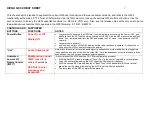
ELK-319PB1 Heavy Duty 1 Button Panic
Description
The ELK-319PB1 is a Wireless Heavy Duty 1 Button Panic
device that that transmits to an alarm panel when pressed. It
can be used police, medical, etc. alarm activation.
The device also transmits low battery (as needed) and is
powered by a single (1) replaceable 3VDC lithium coin-cell
battery.
This sensor is compatible with Elk’s 319MHz Receivers/Panels
as well as many other panels that operate on the 319.5MHz
Frequency and adhere to the ITI/Interlogix protocol.
Specifications
RF frequency: 319.5 MHz
Compatibility: ELK-319 Receivers/Panels & other panels
that operate on the 319.5MHz Freq. and
adhere to the ITI/Interlogix protocol
Battery type: One (1) 3VDC lithium coin-cell battery
(Panasonic or Varta Model CR2450)
Operating
Temp Range: 32 to 120°F (0 to 49°C)
Storage
Temp Range: -30 to 140°F (-34 to 60°C)
Relative
Humidity:
95% non-condensing
Dimensions 3.0” x .2.0” x 0.7” in. (L x W x D)
Accessories: Belt Clip, Lanyard Clip, Wall Mount Bracket
Programming (Enrollment)
The following is a general guideline for programming (enrolling)
a sensor into the receiver or panel. For more extensive
instructions please refer to the receiver or panel instructions.
1. Power up the device by
pulling and removing the
battery isolator tab.
2. Place the panel into the
Program mode.
3. Proceed to the WIRELESS
SETUP menu.
4. Select the appropriate zone/sensor location number.
5. Start the panel sensor Enroll process. When the panel
prompts to trip the sensor for learning do the following:
- Press the Panic Button. The panel should acknowledge
the sensor has been learned by keypad display and/or audio
alert (depending on the panel). If enrollment fails to occur
try repeating the process.
6. Repeat the above process for any additional wireless
sensors. Proceed to the zone programming to assign each
sensor’s zone definition.
7. Exit programming mode when finished.
Testing the Sensor
It is recommend that all wireless sensors be thoroughly tested
after installation and programming.
Wireless Testing
Wireless testing provides a baseline for the distance the panic
sensor will nominally operate away from the control or receiver.
1. Place the panel into the Walk Test mode.
2. Monitor the keypad display while pressing the button. Refer
to the receiver or panel for complete instructions. In some
cases the panel may provide a signal strength indication.
3. Walk away from the panel or receiver and test at various
locations making sure the panel acknowledges.
4. Exit Walk Test mode when finished.
Operational Testing
If the alarm system is centrally monitored then always notify
them prior to operational testing.
1. Press and hold the panic button until the specific alarm
reaction (audible or silent dial report) begins.
2. Disarm the alarm panel to silence or reset the alarm.
Accessory Attachment Options
There are three (3) options for carrying the Panic Button.
TM
Interlogix is a registered trademark belonging to United Technologies.
Belt Clip - allows Panic Button
to be clipped onto a belt or
waistband for handsfree carry
and ease of access.
Wall Mount Bracket - used in
conjunction with the belt clip, this
wall or cabinet mounting bracket
allows the Panic Button to be
attached to a fixed object yet still
be removed for portability.
Lanyard Clip - used in place of the belt clip to allow Panic Button
to hang from a lanyard (not included).
Note: The belt clip must be installed on the panic device to
fit into the bracket
Note: Tighten
the bottom case
screw after
removing battery
tab.
Battery isolation
tab.



















